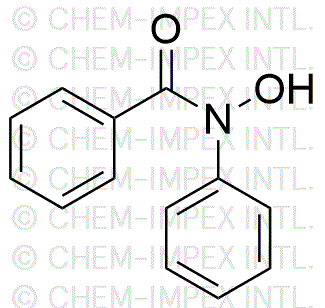N-Benzoyl-N-phenylhydroxylamine is widely utilized in research focused on:
- Analytical Chemistry: This compound serves as a reagent for the detection of aldehydes and ketones, providing a reliable method for qualitative analysis in various samples.
- Pharmaceutical Development: It is used in the synthesis of pharmaceutical intermediates, aiding in the production of drugs that require specific hydroxylamine functionalities.
- Polymer Chemistry: The compound acts as a stabilizer in polymer formulations, enhancing the durability and performance of materials used in coatings and plastics.
- Organic Synthesis: It plays a crucial role in the formation of amides and other nitrogen-containing compounds, streamlining synthetic pathways in organic chemistry.
- Environmental Analysis: N-Benzoyl-N-phenylhydroxylamine is employed in the evaluation of pollutants, helping researchers assess the presence of harmful substances in environmental samples.
General Information
Properties
Safety and Regulations
Applications
N-Benzoyl-N-phenylhydroxylamine is widely utilized in research focused on:
- Analytical Chemistry: This compound serves as a reagent for the detection of aldehydes and ketones, providing a reliable method for qualitative analysis in various samples.
- Pharmaceutical Development: It is used in the synthesis of pharmaceutical intermediates, aiding in the production of drugs that require specific hydroxylamine functionalities.
- Polymer Chemistry: The compound acts as a stabilizer in polymer formulations, enhancing the durability and performance of materials used in coatings and plastics.
- Organic Synthesis: It plays a crucial role in the formation of amides and other nitrogen-containing compounds, streamlining synthetic pathways in organic chemistry.
- Environmental Analysis: N-Benzoyl-N-phenylhydroxylamine is employed in the evaluation of pollutants, helping researchers assess the presence of harmful substances in environmental samples.
Documents
Safety Data Sheets (SDS)
The SDS provides comprehensive safety information on handling, storage, and disposal of the product.
Product Specification (PS)
The PS provides a comprehensive breakdown of the product’s properties, including chemical composition, physical state, purity, and storage requirements. It also details acceptable quality ranges and the product's intended applications.
Certificates of Analysis (COA)
Search for Certificates of Analysis (COA) by entering the products Lot Number. Lot and Batch Numbers can be found on a product’s label following the words ‘Lot’ or ‘Batch’.
*Catalog Number
*Lot Number
Certificates Of Origin (COO)
This COO confirms the country where the product was manufactured, and also details the materials and components used in it and whether it is derived from natural, synthetic, or other specific sources. This certificate may be required for customs, trade, and regulatory compliance.
*Catalog Number
*Lot Number
Safety Data Sheets (SDS)
The SDS provides comprehensive safety information on handling, storage, and disposal of the product.
DownloadProduct Specification (PS)
The PS provides a comprehensive breakdown of the product’s properties, including chemical composition, physical state, purity, and storage requirements. It also details acceptable quality ranges and the product's intended applications.
DownloadCertificates of Analysis (COA)
Search for Certificates of Analysis (COA) by entering the products Lot Number. Lot and Batch Numbers can be found on a product’s label following the words ‘Lot’ or ‘Batch’.
*Catalog Number
*Lot Number
Certificates Of Origin (COO)
This COO confirms the country where the product was manufactured, and also details the materials and components used in it and whether it is derived from natural, synthetic, or other specific sources. This certificate may be required for customs, trade, and regulatory compliance.


